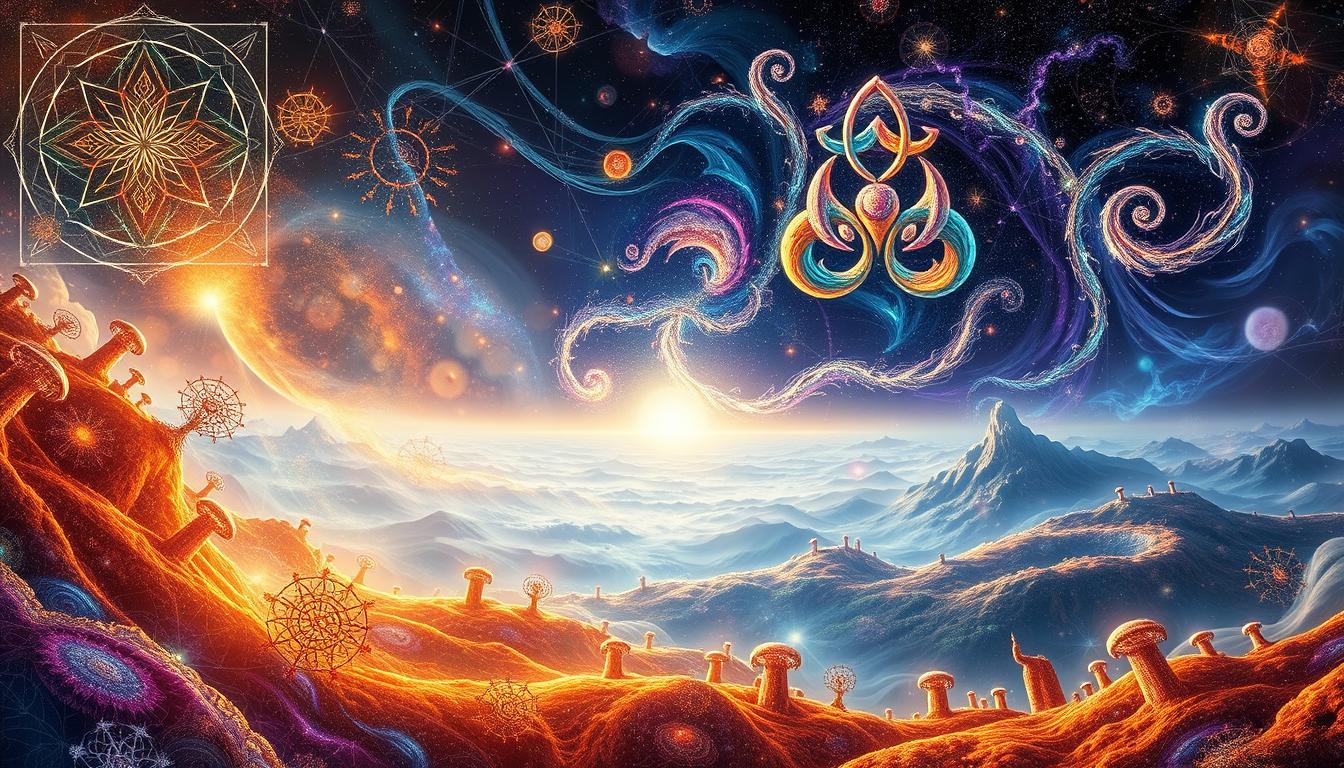The cosmos is a complex and fascinating place. It shows itself through fractals in the universe. As we explore, we find fractal patterns everywhere. These patterns are in big cosmic structures and tiny subatomic particles. They show us deep truths about our universe. This article will talk about how fractals are found at many levels. It will show how they help us understand reality.
Introduction to Fractals and Their Role in the Universe
Fractals are complex and self-similar, playing a major role in physics, biology, and psychology. They show how simple rules can create complex patterns. These patterns appear in everything from snowflakes to coastlines.
Looking at cosmic fractals gives us a peek into how the universe is arranged. The way galaxies group together is like smaller structures repeating. This helps scientists make sense of the cosmos and dig into reality’s basic elements.

The Concept of Fractals: A Brief Overview
Exploring fractals gives us a peek into their unique world, showing shapes that defy ordinary limits. These patterns form through a repeating process. They look the same at any size, a property called self-similarity.
Fractals split into two types: natural and mathematical. Natural ones, like coastlines or snowflakes, are patterns we see around us. Mathematical fractals come from calculations, creating shapes that are fascinating to view.
Learning about fractals helps us admire the world’s complexity. Diving into fractals reveals their importance in understanding the universe and its structure.
What is the fractal nature of the universe
The universe shows its fractal nature through patterns that repeat on different scales. These include big things like clusters of galaxies and the details inside single galaxies. These repeating patterns tell us how the universe is put together and how it works.
The fractal structures observed at various scales
Fractals appear in many forms across the universe. For example:
- The way galaxies gather into complex networks.
- How star systems within galaxies create similar patterns to larger cosmic structures.
- The fine details of nebulae that mirror the larger universe.
This shows fractals’ self-similarity across the vastness of space.
Historical context: Benoit Mandelbrot’s discoveries
Benoit Mandelbrot revolutionized our understanding of the universe’s fractal nature in the late 20th century. He showed the world fractals and how they can explain nature’s complex patterns. Mandelbrot’s discoveries connect chaotic systems to the underlying order in the universe.
The Fractal Dimension of Cosmic Structures
The fractal dimension is key for fathoming the universe’s complexity. It measures the patterns and shapes that galaxies and other space phenomena show. This lets scientists study the self-similarity found across different scales in space.
Understanding fractal dimensions in physics
Fractal dimensions shed light on the physics that control the cosmos. They help describe the structure of galaxies in ways that simple shapes cannot. Understanding these aspects gives us deep insights into how the universe works.
Measuring complexity in universal patterns
To grasp the universe’s complexity, scientists use fractal dimensions. This approach details forms and distributions beyond standard measures. It unveils connections among cosmic bodies, boosting our understanding of the universe’s design.
Galaxies and Their Fractal Patterns
Studying galaxies offers insights into how they spread across the universe. Research shows galaxies are not randomly placed. Instead, they’re arranged in fractal patterns, which are complex and repeat at different scales.
Distribution of galaxies in the universe
Research on galaxies shows they form fractal patterns. Our cosmos looks like a web with clusters of galaxies. This shows in:
- Gravitational interactions between cosmic bodies
- Dark matter’s influence on galaxy formation and clustering
- Variations in cosmic density across vast regions
How fractal patterns emerge in cosmic formations
Fractal patterns in the cosmos come from natural forces. Galaxy collisions, mergers, and the universe’s expansion show us this. Simulations of the cosmos also display these patterns. They link galaxies and fractals deeply.
The Fractal Nature of Subatomic Particles
Subatomic particles are key to the universe’s structure, showing actions linked with fractal energy fields. These fields may change how particles connect. This understanding can deepen our grasp of quantum mechanics and what makes up everything.
Fractal energy fields and their implications
Fractal energy fields form a complex pattern in the universe, which helps us learn about subatomic particles’ behaviors. This pattern allows energy and matter to talk to each other. It has big effects on experiments in physics and on theories.
The interaction of subatomic particles through fractal structure
Usually, we see subatomic particles’ behavior through quantum mechanics. But adding fractal structures uncovers more details. Seeing how these particles move in fractal fields can change how we view their connections. It shows the importance of tiny patterns.
The Holographic Principle and Fractals
The holographic principle is a cool concept. It says the info in a space can be found on its edge. This idea is like fractals, which repeat patterns at different sizes. Both make us see the universe in a new way. We often think our world is three-dimensional. But these ideas suggest it might just be a shadow of something more complex.
Fractals show us how information layers itself, much like stories within stories. This is similar to how holograms store data. It suggests everything in the cosmos might be more connected than we thought. Delving into the holographic principle opens up new ways to see math and physics. It suggests that the universe’s structure might be based on fractal patterns.
Fractal Energy Fields: A Unifying Theory
Studying fractal energy fields could help connect different scientific areas. These patterns aren’t just about math. They impact physical events big and small. They could explain how forces and particles work together, sparking new scientific conversations.
Exploring the unifying theory of fractal energy fields
Fractal energy fields might be key to understanding the universe. Researchers looking at self-similar patterns in these fields could uncover new links between energy, matter, and reality itself. This could change how we see basic physics laws.
Potential applications in high energy physics
If this theory about fractal energy fields is right, it could change particle physics. It might help us get how fundamental particles behave and interact at high-energy levels. This new theory could open the door to different ways of looking at the universe’s energy.
Quantum Fluctuations and the Formation of Galaxies
Quantum fluctuations are vital in the universe’s infancy, seeding galaxy creation. These minor energy changes have huge cosmic impacts. They help us understand how galaxies started forming post-Big Bang.
Understanding cosmic microwave background radiation
Researching cosmic microwave background radiation tells us about the early universe’s conditions. This radiation is like a universe photo, taken just 380,000 years post-Big Bang. By studying its temperature variations, experts see patterns linked to quantum fluctuations. These patterns show how density changes helped build cosmic structures.
From quantum fluctuations to large-scale structures
Quantum fluctuations to large-scale structures show how cosmos events are linked. Tiny density changes grew under gravity’s pull, forming denser mass areas. These became galaxies, showing quantum mechanics’ role in cosmic evolution.
The Multiverse Concept and Fractal Geometry
The idea of multiple universes opens up fascinating ideas about how everything is put together. Especially when we look at it through fractal geometry, a type of pattern. These patterns come from a theory about the universe growing quickly right after it started. They show that what we see might be just a small part of something much bigger.
The relationship between inflation and fractal structures
Inflation theory tells us about a quick growth spurt the universe had right after the Big Bang. This growth led to the creation of various cosmic structures. When this happened, a special kind of pattern called fractal geometry appeared throughout the idea of many universes. These patterns repeat in different parts of space, showing how everything is connected.
This idea highlights how the universe’s quick growth helps to make complex patterns at many levels. These patterns are everywhere, showing the beauty and complexity of space.
Exploring the existence of ‘pocket universes’
The idea of many universes includes the concept of pocket universes. These are separate universes that could exist on their own, each with different rules. Inside each one, there could be its own unique patterns, showing the endless possibilities out there. This thought helps us see not just our own universe but also the bigger picture beyond it.
Fundamental Density Theory and the Universe as a Fractal
The Fundamental Density Theory shows us the universe is like a Menger sponge. This idea gives a cool way to see the universe as a fractal, showing its repeating patterns and complex spaces. These parts help us get how cosmic rules shape the universe’s big picture.
The Menger sponge analogy in cosmic structure
The Menger sponge is a key idea for seeing the universe’s fractal nature. It shows the universe’s deep complexity, like how empty spaces and clumps of stuff make up space’s density. This repeating patterns idea shows up in different sizes across the cosmos, supporting the Fundamental Density Theory.
Parameters influencing the structure of the universe
Many cosmic parameters shape the universe’s growth and structure. Things like how dark matter spreads, gravity, and energy changes are crucial. Looking into these aspects helps scholars understand the fractal universe’s behavior better, enriching our knowledge of cosmology basics.
Conclusion
We’ve learned a lot about the universe’s fractal nature. It links different scales of reality, from galaxies to tiny particles. Grasping fractal patterns helps us understand the universe’s structure better. It also shows how important fractals are in physics and metaphysics.
This topic connects many areas, suggesting exciting research possibilities. Digging into fractal geometry could revolutionize our grasp of complex systems. It may impact fields from quantum mechanics to big universe theories. As science explores these complex patterns, fractals will stay key in advancing our knowledge and philosophy.
Seeing the universe as a fractal structure lets us view it as a complex patterned tapestry. It highlights the unity and beauty in the cosmos’s complexity. As we continue this exploration, we’re bound to discover even deeper truths about our universe and our role in it.



